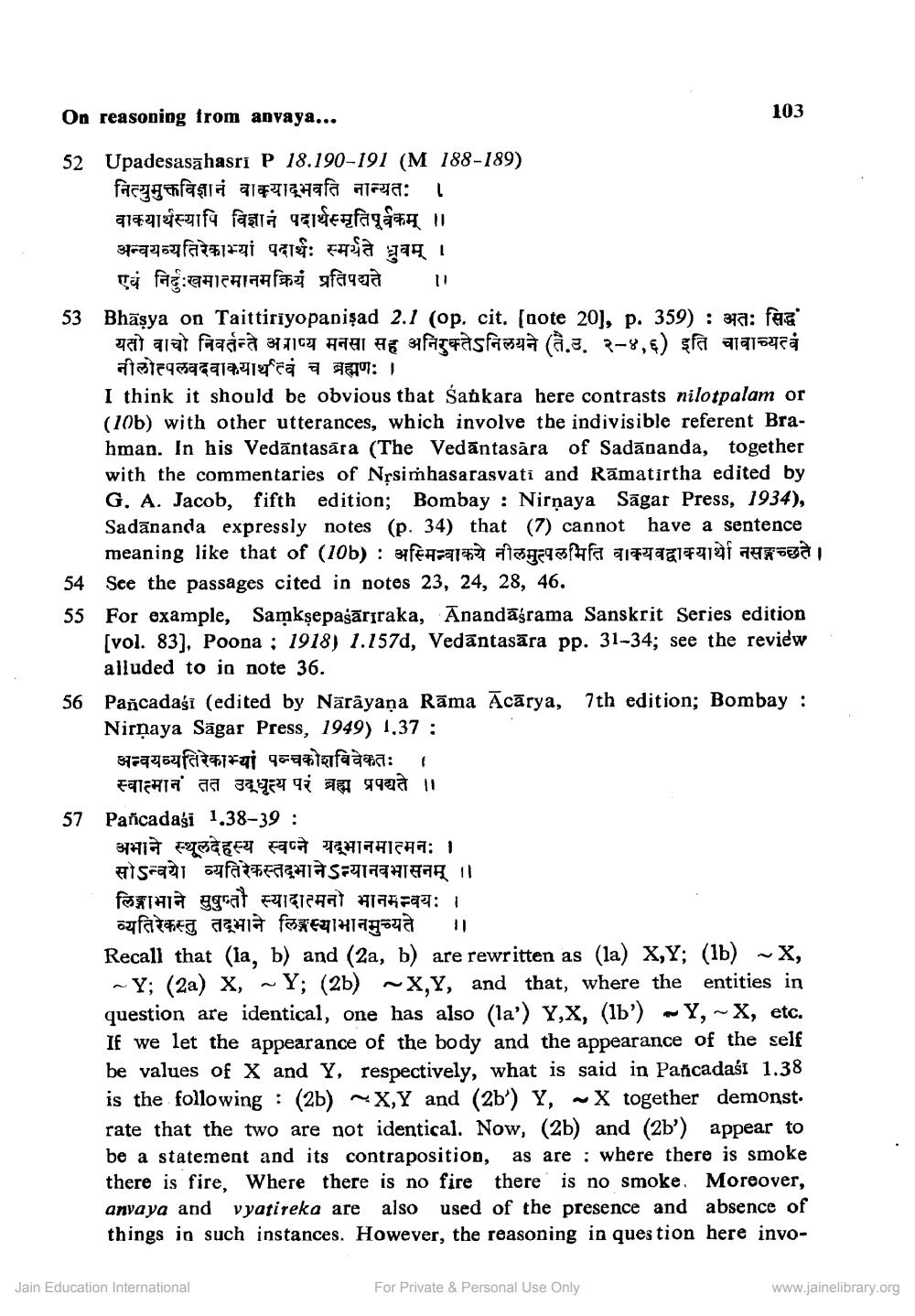________________
On reasoning from anvaya...
103
52
53
54 55
56
Upadesasahasri P 18.190-191 (M 188-189) नित्युमुक्तविज्ञानं वाक्याभवति नान्यत: । वाक्यार्थस्यापि विज्ञानं पदार्थस्मृतिपूर्वकम् ।। अन्वयव्यतिरेकाभ्यां पदार्थः स्मर्यते ध्रुवम् । एवं निर्दुःखमात्मानम क्रियं प्रतिपद्यते ॥ Bhasya on Taittiriyopanisad 2.1 (op. cit. [note 20], p. 359) : अतः सिद्ध यतो वाचो निवर्तन्ते प्राप्य मनसा सह अनिरुक्तेऽनिलयने (ते.उ. २-४,६) इति चावाच्यत्वं नीलोत्पलवदवाकयार्थत्वं च ब्रह्मणः । I think it should be obvious that Sankara here contrasts nilotpalam or (10b) with other utterances, which involve the indivisible referent Brahman. In his Vedantasāra (The Vedantasāra of Sadananda, together with the commentaries of Nysiṁhasarasvati and Rāmatirtha edited by G. A. Jacob, fifth edition; Bombay : Nirnaya Sagar Press, 1934), Sadānanda expressly notes (p. 34) that (7) cannot have a sentence meaning like that of (10b) : अस्मिन्वाकये नीलमुत्पलमिति वाक्यवद्वाक्यार्थी नसङ्गच्छते । Sce the passages cited in notes 23, 24, 28, 46. For example, Samksepasariraka, Anandaframa Sanskrit Series edition [vol. 83], Poona: 1918) 1.157d, Vedantasara pp. 31-34; see the review alluded to in note 36. Pancadagi (edited by Narayana Rama Acārya, 7th edition; Bombay : Nirnaya Sagar Press, 1949) 1.37 : अन्वयव्यतिरेकाभ्यां पन्चकोशविवेकतः । स्वात्मानं तत उद्धृत्य परं ब्रह्म प्रपद्यते ।। Paricadagi 1.38-39 : अभाने स्थूलदेहस्य स्वप्ने यभानमात्मनः । सोऽन्वया व्यतिरेकस्तभानन्यानवभासनम् ।। लिजाभाने सुषुप्तौ स्यादात्मनो भानमन्वयः । व्यतिरेकस्तु तभाने लिङ्गस्याभानमुच्यते ॥ Recall that (la, b) and (2a, b) are rewritten as (la) X,Y; (1b) ~X,
~Y; (2a) X, ~Y; (2b) ~x,Y, and that, where the entities in question are identical, one has also (la') Y,x, (1b') - Y,~X, etc. If we let the appearance of the body and the appearance of the self be values of X and Y, respectively, what is said in Pancadasi 1.38 is the following : (2b) Ax,Y and (2b') Y, ~x together demonst. rate that the two are not identical. Now, (2b) and (2b') appear to be a statement and its contraposition, as are : where there is smoke there is fire, Where there is no fire there is no smoke. Moreover, anvaya and vyatireka are also used of the presence and absence of things in such instances. However, the reasoning in question here invo
57
Jain Education International
For Private & Personal Use Only
www.jainelibrary.org




